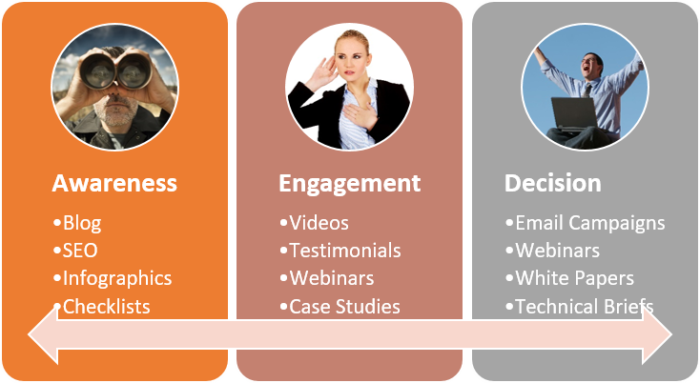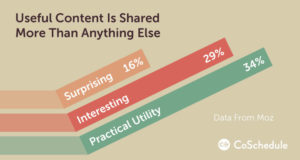Because your end-stage content is worthless if no one knows you’re there.

The goal of the awareness stage is not to sell, not yet. The goal of the awareness stage is to:
- Identify with your prospect on the nature of their problem.
- Educate your prospect on solutions to the problem
- Make your content attractive and available so your prospect will consume it.
In my day, we walked uphill to school. Both ways.

In my misspent youth, I worked for many years in IT. We didn’t need some vendor telling us what our problems were. Half the time they didn’t understand them anyway, and the other half of the time they tried to sell us a solution that we didn’t want.
But sometimes a vendor came along that did two things: first, they really understood what our issues were in our environment, sometimes better than we did because they spent so much time thinking about the problem and how to solve it. Second, they communicated practical steps to solve it that didn’t necessarily include their product. Third, they weren’t jerks – we liked them as people.
This approach developed an atmosphere of mutual respect and short-circuited the defenses that any buyer throws up when someone is trying to sell them something. When we were sold on the vendor’s understanding of our problem, we were more inclined to believe that they might have the solution too.
At that time, most of this interaction happened at conventions, or initial sales calls, or even vendor briefings that they know what they were doing.
These days this awareness stage primarily happens online. Problem/solution education remains the same, but attractive and highly available content replaces the initial sales call chemistry. However, vendors must still take the initiative to reach prospects. These days, that means less cold calls and more being Johnny-on-the-spot when prospects search online for information.
Expose your content to the right readers.
There are two primary awareness stage channels: Google search and social media exposure.
Google is still the 1000-pound gorilla.
When it comes to online research, Google is still the king of the world. You need to do everything that you can do to encourage Google’s algorithms to position you far up in the natural search order. (PPC can work too but not for everyone.) This is why you still need strong SEO based on highly targeted longtail keywords. To know what those keywords are, you need to understand your prospects’ pain points — exactly what I’ve been talking about for the last page or so.
Your prospects may not be looking exactly for your product. But they will be seeking related answers. Let’s say for example that you develop software that creates virtual clusters in VMware environments without having to adopt VVOLS. VMware owners search using phrases like “how hard is VVOLS” or “how to deploy VVOLS” or “virtual volumes VMware.” Learn these keyword phrases and include them in your content, where you explain that yes indeed VVOLS is complicated and there are simplified solutions to developing highly elastic virtual volume clusters. (No insult meant to VMware, which is a great company. But competition is good for the soul.)
The best opportunity for awareness stage SEO is frequent keyword-centered blog posts. Google likes fresh new content and it likes the intelligent use of keywords and keyword phrases. And once your prospects read your interesting blog, CTAs expose them to more educational content.
Social media gets its share of the love.
The second primary channel for the awareness stage is social media. For B2B technology marketing that is largely LinkedIn, Twitter, and YouTube. (YouTube is the second-largest search engine behind Google.)
There are other avenues. Some businesses use Facebook well, others use Instagram and Pinterest, some use Google+. I’m not knocking these sites but if you’re going to do social media – and you should – then make good use of the Big Three.
For the awareness stage, use LinkedIn to build thought leadership and trust with your executives and your company. Republish your blogs as LinkedIn articles with linked CTAs at the bottom of your articles. You might do this once a week or once every two weeks along with daily status updates. As with all your awareness stage content, concentrate on understanding problems and educating on solutions.
Use Twitter to make pithy comments and link to educational assets, including your own. (Note that it’s OK to be amusing on this platform – my favorite tweet ever is the CIA’s very first official tweet: “The CIA does not confirm or deny this tweet.” Talk about humanizing a spy agency.)
What Kind of Content?
Let’s drill down into the tone and types of content that work best at the awareness stage. At this point, you want to use a conversational and relatable tone. A note here: if your content is usually highly technical, please do not use the horrible phrase “dumbing down.” Your prospects are a bunch of very smart people, and you will not be dumbing down anything. What you will be doing is taken the first steps to building a trusted relationship with of them. And if your content assumes too much familiarity with your product, you will never get eyes in the first place.
A conversational, attractively designed, and interesting asset designed to get attention is what you’re after. Intelligently use your prospects’ search phrases and keywords for Google attention. This type of content is also very well-suited to the world of social media, which positively responds to highly visual and well-organized content with compelling headlines.
- Educational blogs. This is not the place for the technical how-to blog, although readers will notice technical blogs in the feed. Focus the educational blog on identifying and resolving problems. The more blogs of this type the better, since you can leverage them as LinkedIn articles, cut them apart for status postings, and put them together for awareness stage e-books and other assets.
- Social media postings.Share your blog posts and other content assets in LinkedIn status updates and articles, and as Tweets. Post a status at least once a day and follow industry influencers and prospects. Don’t be stalker-ish — you will be posting and following as an individual, but build those relationships and that interest.
- You can use videos on your website and on hosting platforms, but make sure you keep a lot of them on YouTube. Millions of users issue search requests on the application every day, and not all of them are for cat videos. If someone wants to know more about virtual failover in the cloud, then educate them about it –becoming a trusted leader in the process.
- Website. Make sure that your website includes awareness stage content like your educational blogs. Don’t be afraid of landing pages either. When you post an awareness blog or article with a link back to your website, you don’t necessarily want to go to the homepage with a listing of your products. You might want to link to an attractive landing page with your assets, and offers for more. Consider gating some of your content for email sign-ups, and include subscribe links on most pages. By the way, some engagement marketers are preaching that email has reached the end of its usefulness, but that’s silly. Email is still enormously useful for lead and customer nurture. Don’t ignore it, use it.
- Webinars (maybe). Webinars have saturated the market and their popularity is waning. Still, a well-produced educational webinar hosted on a popular site like BrightTALK can get good interest and leads.
- Downloadable content. Content assets are the workhorses of your content download and sharing strategy. The ones that count the most at the awareness stage are the ones that are easy to consume, visually attractive, and practical. The usual suspects include checklists, infographics, e-books, videos, and testimonials. Not only are these easy to consume, they are simple to share in social media.

Be strategic in the awareness stage. Don’t try to short-circuit the process; people in this stage are not ready to buy yet. Remember that you are working against inertia. It can be far easier to let the problem continue then to take the initiative and spend the budget to solve it.
By easing them into the process, you spur their interest. By educating them, you generate interest in their need for solution. Ideally, they will discover the solution in your product, which they are now inclined to trust.
 HubSpot ran a seriously interesting study on Twitter, LinkedIn, and Facebook social media publishing. The original article is here: “How Frequently Should I Publish on Social Media? A HubSpot Experiment”
HubSpot ran a seriously interesting study on Twitter, LinkedIn, and Facebook social media publishing. The original article is here: “How Frequently Should I Publish on Social Media? A HubSpot Experiment”




